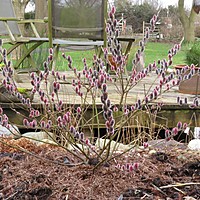2 March 2020
Floods
It’s 16 February and most of our front garden is under water. Some people will be undergoing the misery and destruction of their houses being flooding yet again. I can’t imagine how devastating it must be.
On a much, much less serious note, our gardens are suffering too. Bulbs hate being waterlogged and can rot, trees in boggy areas have their roots in water and end up not being able to breathe and thrive, grey leaved plants hailing from hotter countries sulk and die. It is easy to get despondent.
But plants are amazingly resilient. When we had our pond refurbished, a large skip sat right on top of my prize tree peony for 3 weeks. That’s a goner I thought – but no, it is back and thriving, currently over a metre high and full of buds. So my advice to you if you are looking at the muddy mess that your garden may be in right now, be patient. Wait a while and you never know, by the time Summer arrives your plants may come back, revived after a good long drink and ready to adorn your garden for many more years to come.
One new acquisition that has enjoyed the wet conditions is a multi-stemmed willow with bright pink catkins (see photo). I admit it’s a bit blousy, but it really makes me smile every time I walk by. The picture I know is in black and white, but if you can imagine the catkins a bright plum colour, you will get the idea. I will also tweet it in its full glory via @katescuttings. It’s ironic that not many years ago we were all advised to grow drought tolerant plants such as catmint, phlomis, lavender and cistus. Now I feel the need to steer you towards plants that will survive in a bog: day lilies, hostas, primulas, some iris and my current favourite bog plant, Darmera. I’ve been accumulating a number of roses over the last few years and they clearly don’t seem to mind their toes in wet, heavy soil: if you want to buy a bare root rose or fruit tree you need to get on with it as March is regarded as the latest time to plant. You can, of course, buy them in a container throughout the year, but they are usually more expensive and need watering like mad. I did, in the end, succumb to that Sarah Raven rose I wrote about last time, ‘’Wild Rover’. It goes without saying it has been well watered in!
If, like me, you have bought spring bulbs in pots for either the house or the garden, you can plant them out once they have finished flowering. Take off the flower heads and leave the leaves as they will feed the bulb to ensure a good display next year. Give them a liquid feed if you have it, and plant them in a well-drained spot that gets a few hours of sun at least. The rule of thumb is to plant bulbs at least twice their depth, pointy side up. I pop them in right by perennials such as hardy geraniums and alchemilla mollis so their leaves cover up the bulbs when they are done. Don’t chop off the leaves of your daffodils or tie them in a knot. If you do so you will weaken the plant and make them less likely to flower next year.
I hope we have all dried out a bit by the time you read this. Spring is now with us – hooray!
